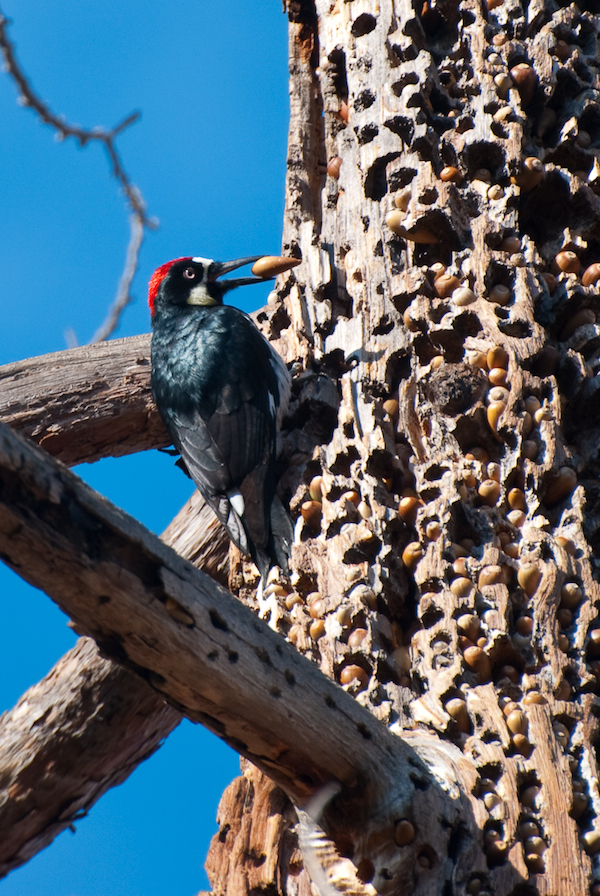We will return again this month to Turtle Bay and environs to view all the wintering waterfowl. As in January we will walk around Turtle Bay, the pedestrian walkway on the Hwy.44 bridge and maybe Kutras Lake. Assemble in the parking lot on the south side of the Redding Civic Auditorium. Brooke McDonald will lead.
Tag Archives | Wintu Audubon
Discover Birding at Turtle Bay
Our youth/beginner bird walks are conducted at Turtle Bay on the first Saturday of the month throughout the year. February is especially birdy at Turtle Bay with all the wintering waterfowl. Wintu Audubon can provide binoculars and field guides. Call Dan Greaney, 276-9693, with questions or for more information. Please remember that we now assemble at the Venture Properties parking lot. Take the first left before the Redding Civic Auditorium.
The Hoarders: Birds That Store Food

Acorn Woodpecker Granary
Last month in the Birdwords column we heard about the yellow-billed magpie and its relatives in the crow (or corvid) family. Birds in that group store food away for later, also known as caching. That trait also shows up in many other species that are not related to the corvids – or to each other either.
You may see several of our common backyard birds visiting your feeders too frequently to be eating all that bounty on the spot. Both the perky little gray birds with the jaunty crest – the oak titmouse; and the sleek white, gray and black tree-clinger – the white-breasted nuthatch – can be observed doing this. In both species, a bird will carefully select a seed – often discarding ones that don’t meet its standards – and dart off to lodge the seed firmly in a crevice in the bark of a nearby tree. Studies have shown that they have remarkable memories as to where their stashes are located. In the black-capped chickadee, a close cousin of our oak titmouse, it has been found that the structures in the brain involved in memory are more highly developed than in non-caching species – although I don’t think the question has been answered as to which came first: the behavior or the brain modification.
Among the woodpeckers, there are several species that hoard food – most notably, the acorn woodpecker. If you look around, you are bound to see trees with many small holes excavated by acorn woodpeckers. Each hole was made to accommodate a single acorn. These are called granary trees. To the chagrin of ranchers, these birds don’t limit themselves to trees but will also puncture fence posts and barn walls. I’ve even seen power poles used as granaries.
Acorn woodpeckers are togetherness birds – they form a colony of a number of individuals to fill and use their granaries. They even nest communally – a behavior not seen in other woodpeckers, in which a pair will nest alone. The granaries are vigorously defended. Acorn woodpeckers go on red alert if a western scrub jay comes near. The jay is definitely not above conducting a raid if a granary is left unguarded, so the potential thief must be chased away.
The acorn woodpeckers’ acorns are strictly for their own benefit. However, various species of jays inadvertently aid the oak trees as well. They hide acorns by burying them in the ground. A certain percentage of the seeds don’t get retrieved and eaten before they have germinated and sprouted into baby trees. Young oak trees can’t grow in the shade of a parent tree, so by” planting” them elsewhere, the jays help regenerate and spread the oak forest.
A botanist noticed this connection and did some mapping. If he superimposed the areas of the world where various species of jays live over a map of the occurrence of all the oak forests of the world a remarkable pattern emerged. There were some places that had jays but no oaks – but there were no oaks where there were no jays. So, our familiar pesky western scrub jay is actually a forester!
You may have noticed this year’s acorn crop has been a good one. Keep your eyes open as the cooler days of autumn spur our avian friends to lay in their supplies for winter!
Local Weekday Bird Walk at Clover Creek
This preserve within the city limits has a large, permanent pond with surrounding cattails and reed marsh, shallow winter pools and uplands planted to oaks. We should see species rare to urban areas such as Western Meadowlark, Western Bluebird, Say’s Phoebe and a variety of ducks and other waterfowl. The Great-tailed Grackle has expanded its range northward to include Shasta County and inhabits the cattail marsh. Meet your trip leader, Linda Aldrich, at the preserve near the south end of Shasta View Drive for this ½-day trip.
Second Saturday Bird Walk at Battle Creek Wildlife Area
The Battle Creek Wildlife Area totals 582 acres of riparian forest, marshes and oak woodlands and hosts a diverse variety of migratory and resident birds. We plan to be in the field 3-3/12 hours walking approx. 3 miles primarily on level improved trails. A pit type toilet is available at the parking area, No drinking water is available. Following the walk we will check-out the Hummingbird feeders at the hatchery and eat lunch. We will be leaving from the south parking lot of the Redding Civic Auditorium at 8:00 am to carpool or meet us at the Battle Creek Wildlife Area around 8:30.
